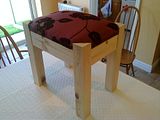Mikey R
Established Member
Hi,
Im in the process of building the legs of a bench, laminated from B&Qs finest softwood 2 x 4s. The legs are approximately 90mm x 115mm, the stretchers are approx 95mm x 40mm with 18mm thick tennons on the ends. This is my first bit of real joinery, and Im quite pleased with the result so far. I will be drawboring the tennons into the morices in the legs, but I would like some advice on what specie to use for the pegs.
The options from the offcut box are either hard maple, american ash or black cherry.
I am leaning towards cherry pegs, in 10mm holes, offset by 2mm or so. I suspect that the harder, stiffer maple and ash would do more damage to the soft pine than they would help.
Does this sound reasonable?
Im in the process of building the legs of a bench, laminated from B&Qs finest softwood 2 x 4s. The legs are approximately 90mm x 115mm, the stretchers are approx 95mm x 40mm with 18mm thick tennons on the ends. This is my first bit of real joinery, and Im quite pleased with the result so far. I will be drawboring the tennons into the morices in the legs, but I would like some advice on what specie to use for the pegs.
The options from the offcut box are either hard maple, american ash or black cherry.
I am leaning towards cherry pegs, in 10mm holes, offset by 2mm or so. I suspect that the harder, stiffer maple and ash would do more damage to the soft pine than they would help.
Does this sound reasonable?






